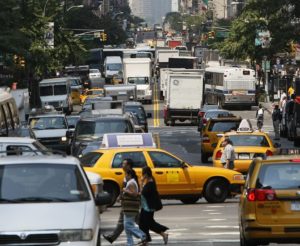 Air pollution is a killer, but it also does damage in subtle ways - such as having effects on the brain. A recent study found that early childhood exposure to high amounts of traffic-related air pollution (city life, living next to a highway) resulted in the brain having structural changes (differences in brain volume and cortical thickness) at the age of 12 when compared to children who did not have such high exposure to traffic-related air pollution. This means that the changes were permanent.
Air pollution is a killer, but it also does damage in subtle ways - such as having effects on the brain. A recent study found that early childhood exposure to high amounts of traffic-related air pollution (city life, living next to a highway) resulted in the brain having structural changes (differences in brain volume and cortical thickness) at the age of 12 when compared to children who did not have such high exposure to traffic-related air pollution. This means that the changes were permanent.
The study was conducted in Cincinnati, Ohio, but traffic-related air pollution (TRAP) is a problem throughout the world. This type of air pollution has all sorts of gaseous pollutants, fine and ultrafine particles, heavy metals, carbon, and polycyclic aromatic hydrocarbons. Diesel exhaust may be even worse - it has more than 40 toxic pollutants. When people breathe in the pollutants, the pollutants then can travel to the brain where they can cause damage.
What will it take for governments to really accept the dangers of air pollution and to take the hard steps necessary to toughen standards? Instead of loosening all sorts of pollution standards, which is what is going on in the United States today.
[More studies about air pollution and the brain, including higher risks of dementia, millions of ultra-fine particles getting to the heart and brain and lodging there, and shrinking of brain volume.]
From Science Daily: High air pollution exposure in 1-year-olds linked to structural brain changes at age 12
A new study suggests that significant early childhood exposure to traffic-related air pollution (TRAP) is associated with structural changes in the brain at the age of 12.
The Cincinnati Children's Hospital Medical Center study found that children with higher levels of TRAP exposure at birth had reductions at age 12 in gray matter volume and cortical thickness as compared to children with lower levels of exposure.
"The results of this study, though exploratory, suggest that where you live and the air you breathe can affect how your brain develops, says Travis Beckwith, PhD, a research fellow at Cincinnati Children's and lead author of the study. "While the percentage of loss is far less than what might be seen in a degenerative disease state, this loss may be enough to influence the development of various physical and mental processes."
Gray matter includes regions of the brain involved in motor control as well as sensory perception, such as seeing and hearing. Cortical thickness reflects the outer gray matter depth. The study found that specific regions in the frontal and parietal lobes and the cerebellum were affected with decreases on the order of 3 to 4 percent.
The researchers on the study, which is published online in PLOS One, used magnetic resonance imaging to obtain anatomical brain images from 147 12 year olds. These children are a subset of the Cincinnati Childhood Allergy and Air Pollution Study (CCAAPS), which recruited volunteers prior to the age of six months to examine early childhood exposure to TRAP and health outcomes.
The volunteers in the CCAAPS had either high or low levels of TRAP exposure during their first year of life. The researchers estimated exposure using an air sampling network of 27 sites in the Cincinnati area, and 24/7 sampling was conducted simultaneously at four or five sites over different seasons. Participating children and their caregivers completed clinic visits at ages 1, 2, 3, 4, 7 and 12.
Previous studies of TRAP suggest that it contributes to neurodegenerative diseases and neurodevelopmental disorders. This work supports that TRAP changes brain structure early in life.
